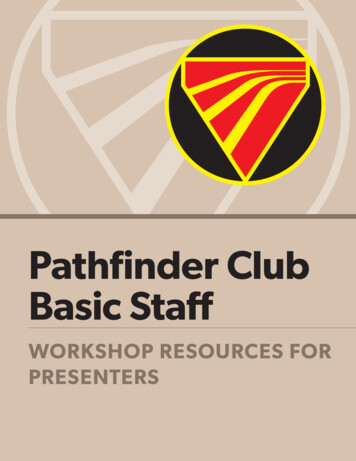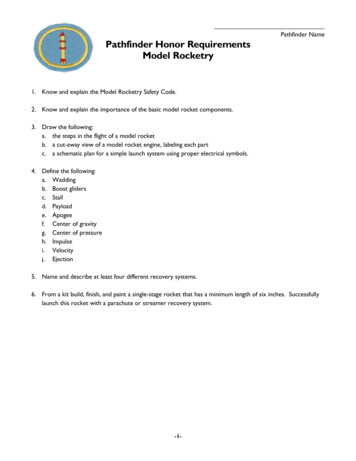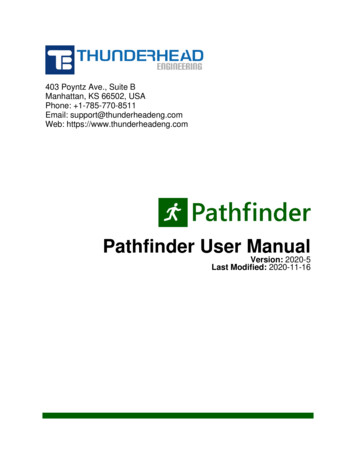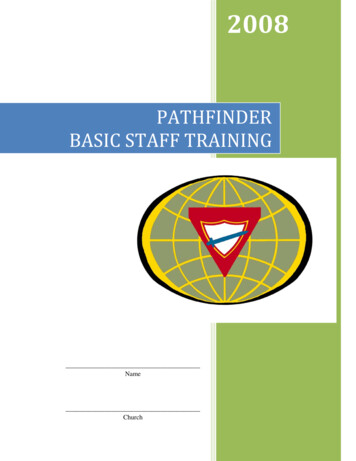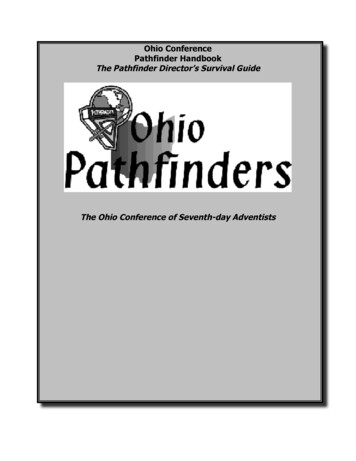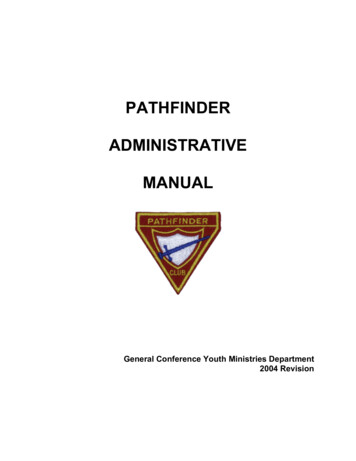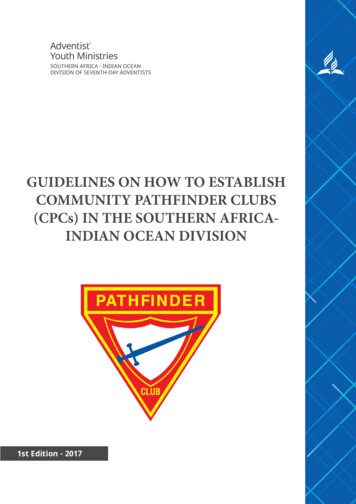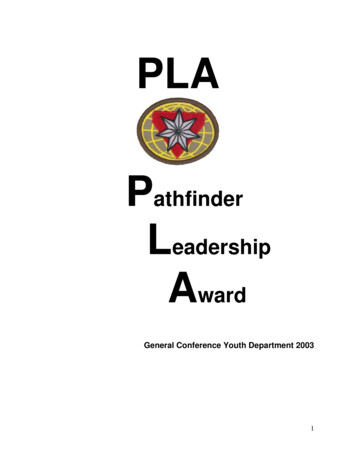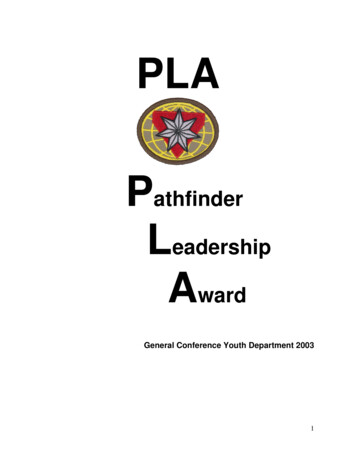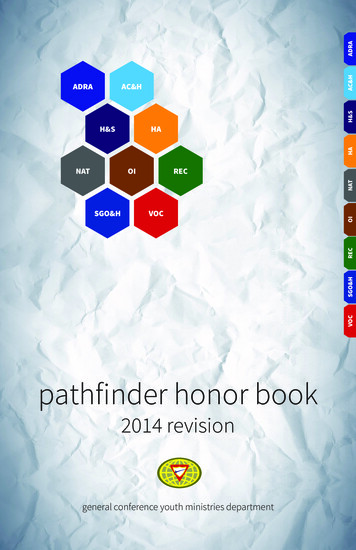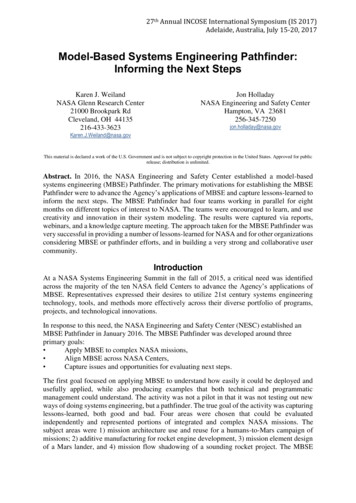
Transcription
27th Annual INCOSE International Symposium (IS 2017)Adelaide, Australia, July 15-20, 2017Model-Based Systems Engineering Pathfinder:Informing the Next StepsKaren J. WeilandNASA Glenn Research Center21000 Brookpark RdCleveland, OH 44135216-433-3623Jon HolladayNASA Engineering and Safety CenterHampton, VA and@nasa.govThis material is declared a work of the U.S. Government and is not subject to copyright protection in the United States. Approved for publicrelease; distribution is unlimited.Abstract. In 2016, the NASA Engineering and Safety Center established a model-basedsystems engineering (MBSE) Pathfinder. The primary motivations for establishing the MBSEPathfinder were to advance the Agency’s applications of MBSE and capture lessons-learned toinform the next steps. The MBSE Pathfinder had four teams working in parallel for eightmonths on different topics of interest to NASA. The teams were encouraged to learn, and usecreativity and innovation in their system modeling. The results were captured via reports,webinars, and a knowledge capture meeting. The approach taken for the MBSE Pathfinder wasvery successful in providing a number of lessons-learned for NASA and for other organizationsconsidering MBSE or pathfinder efforts, and in building a very strong and collaborative usercommunity.IntroductionAt a NASA Systems Engineering Summit in the fall of 2015, a critical need was identifiedacross the majority of the ten NASA field Centers to advance the Agency’s applications ofMBSE. Representatives expressed their desires to utilize 21st century systems engineeringtechnology, tools, and methods more effectively across their diverse portfolio of programs,projects, and technological innovations.In response to this need, the NASA Engineering and Safety Center (NESC) established anMBSE Pathfinder in January 2016. The MBSE Pathfinder was developed around threeprimary goals: Apply MBSE to complex NASA missions, Align MBSE across NASA Centers, Capture issues and opportunities for evaluating next steps.The first goal focused on applying MBSE to understand how easily it could be deployed andusefully applied, while also producing examples that both technical and programmaticmanagement could understand. The activity was not a pilot in that it was not testing out newways of doing systems engineering, but a pathfinder. The true goal of the activity was capturinglessons-learned, both good and bad. Four areas were chosen that could be evaluatedindependently and represented portions of integrated and complex NASA missions. Thesubject areas were 1) mission architecture use and reuse for a humans-to-Mars campaign ofmissions; 2) additive manufacturing for rocket engine development, 3) mission element designof a Mars lander, and 4) mission flow shadowing of a sounding rocket project. The MBSE
Pathfinder also expanded the use of a NASA Cloud infrastructure for software tools and asystem modeling collaboration area.The second goal focused on the cultural and technical challenge of aligning the MBSEcommunity across NASA. NASA has many users of MBSE at its Centers, but until recentlythere was little coordination or guidance among these efforts at the Agency level. A previousagency-level activity had evaluated the digital architecture needed for MBSE and those resultswere available for reference. Both the Jet Propulsion Laboratory and the Goddard Space FlightCenter had hosted workshops covering a broad range of related topics. Numerous other Centershad MBSE working groups and were in the process of developing plans for future engagement.In addition, roughly three dozen classes had been presented on MBSE and related topics at thedifferent Centers. A solicitation for the MBSE Pathfinder was sent to all ten Centers, andparticipants were organized into virtual teams that were diverse in geographical location,discipline background, aerospace experience, and MBSE experience. This team environmentfully challenged the implementation of MBSE, this time with an emphasis on culture so thatlessons-learned could be maximized.The third goal focused on capturing lessons-learned, so that next steps at the agency-levelwould be informed by hands-on experiences doing the work that was typical of real NASAmissions.The benefits of using MBSE were presented in a recent International Council on SystemsEngineering publication (Miller, 2015) and are not discussed here.ApproachThe approach chosen for the MBSE Pathfinder was to solicit nominations for the teams in thefour focus areas. Because the level of experience of the participants was not known during theplanning period, it was decided to break apart the problem and focus on learning, creativity,and innovation in system modeling of an existing system or concept rather than learning howto do system modeling while at the same time defining a new system. The teams were asked tocapture lessons-learned and recommendations for next steps along the way and at the end.Planning and Start-upPlanning for the MBSE Pathfinder occurred over the fall of 2015 to outline the top-levelobjectives, schedule, resources and training, and topic areas. The activity was to begin inFebruary and conclude in September 2016. The participants were to be provided introductorytraining, travel to the training and at least one face-to-face meeting, and access to a consistentset of tools. The Centers were asked to provide labor hours for the participants at 75% time.Desired qualities of a participant were experience or ability to learn system modeling; capableof working in a fast-paced, diverse multi-center culture; able to learn and communicate withthe home Center; and ability to innovatively engage systems engineering implementation. Theobjectives were fairly broad in the initial call, so the four teams were asked to define detailedobjectives, milestones, schedules, and deliverables in their work plans. The NASA ProgramExecutive for the NASA Cloud agreed to provide information technology resources, softwarelicenses for the MBSE Pathfinder, and personnel to support the activity.The NASA Systems Engineering Technical Fellow issued a call in January 2016 fornominations from all NASA Centers. Placement of the nominees on the teams was done topromote diversity of home Center, technical area, and aerospace and system modelingexperience, as shown in Table 1. Each of the teams had a lead and five to eight participants.The average NASA or aerospace experience level of each participant was 19 years, with a range
of 4 to 40 years. Two of the team leads were very experienced and two had less than ten years.Over half of the participants had not applied MBSE to real missions. Summer students andinterns also participated, and some participants worked on two or more teams. Severaladditional people served as the MBSE Pathfinder management team to provide leadership,implementation, and advice and guidance.Table 1: MBSE Pathfinder Team InformationNumber of participantsNumber of CentersEngineering disciplinesAerospace experience25 years11 to 25 years0 to 10 yearsPrevious MBSEexperienceHighMediumLowNoneTeam m 265aerospacemechanicalsystemsTeam 385electricalmechanicalsoftwaresystemsTeam 3321130A virtual kick-off teleconference in early February began the work in earnest. The kickoffcovered the goals and objectives of the work and how it relates to systems engineeringadvancement at NASA, an overview of MBSE and the MBSE Pathfinder approach, and theschedule of events. The participants were given reading and video assignments and asked tobegin working with their teams on drafting work plans.The first face-to-face meeting occurred in late February at the Wallops Flight Facility (WFF).Since this was the first time most of the participants had met each other, several sessions werescheduled to promote team-building and preparation and review of the teams’ work plans. Themeeting included three days of introductory hands-on SysML training.Operating RhythmAll participants were invited to attend monthly teleconferences, which began in March. Eachteam presented highlights of their progress and could request assistance for issues. The teamleads and MBSE Pathfinder management team also had a brief weekly teleconference.Three face-to-face meetings were held; the first was the one mentioned above. The secondmeeting was a mid-term in May at the Johnson Space Center. This meeting served as a checkpoint to see how the teams were doing, address issues, and prepare for the remaining monthsof work. The agenda featured sessions by participants on topics such as system and softwareengineering tools, model-based project management, model verification and validation,capturing stakeholder information, and the use of patterns and reference models. The teamspresented overviews of their work to date and were given feedback and suggestions on both
the good and the not-so-good. Time was allotted for the teams to work face-to-face to assesstheir progress and make updates to their work plans. The third meeting was for knowledgecapture in September at the Langley Research Center. The agenda featured special topicsessions and open discussions on various aspects of MBSE and the MBSE Pathfinder, to drawout lessons-learned. The meeting concluded with summary presentations by each team, asummary presentation to key agency-level stakeholders, and recognition of the achievementsof each participant.Teams 2 and 4 each held a face-to-face meeting. Team 2 used their face-to-face meeting towork with each other in real-time, and to see test components. Team 4 had a TechnicalInterchange Meeting with the Sounding Rocket Program Office and the NASA SoundingRocket Operations Contract (NSROC) customers to discuss and evaluate the modeling effort.Each of the four teams produced a final report and summary presentation charts, and providedthe system model(s). The Implementation Lead compiled the recommended next steps andgrouped them into actionable areas for planning a follow-on effort.Resources for ModelingThe NASA Office of Chief Information Officer hosted the systems engineering andcollaboration software tools as part of the Agency Cloud provisioning pilot. The commercialsoftware tools included multiple licenses of systems engineering software tools, a central modelrepository, a collaboration tool, a simulation toolkit, and data exchange tools with interfaces toa variety of other tools. In addition, the MBSE Pathfinder participants were able to use severalplugins and modules that resided at NASA Centers.The MBSE Pathfinder participants were provided with links to on-line webinars; severalreference books on system modeling, MBSE, and SysML; and the introductory hands-onSysML class. The training instructors were retained as advisors and provided guidance to solveissues and gave feedback on the teams’ models. Other advisors helped the teams throughoutthe remaining months. Many of the MBSE Pathfinder participants were experienced in MBSEor knew of knowledgeable people at their home Centers and shared their expertise.ResultsGoals, Objectives, and AccomplishmentsEach of the four teams defined their specific goals and objectives for their work and statedthem in their work plans. Some goals and objectives were common, and fell into the generalcategories of construct a system model by either using existing information or shadowing anexisting project, generate technical review products, investigate import and export capabilitiesand interactions with physics-based tools, and investigate model reuse. All the teams hadsignificant accomplishments and findings.The teams focused on different levels of system architectures ranging from campaign andmission to subsystems to construct a system model for their topic area. Team 1 modeled acampaign and mission architecture based on a published campaign architecture for humanexploration of Mars (Arney, 2015). Team 2 modeled the new development of a liquid rocketengine. The elements modeled included the needs, goals, and objectives; constraints;hierarchical diagrams; use cases; engine requirements; and data management. Team 3 modeledsystems and subsystems typical for a spacecraft, and studied system and physicaldecomposition and interfaces. Team 4 created an interconnected model of the Multiple UserSuborbital Instrument Carrier (MUSIC) sounding rocket project. The team used the Sounding
Rocket Design Review requirements and MUSIC mission technical review data package astheir primary information sources.The teams looked at different parts of a project lifecycle and used the system model to generatetechnical products for different reviews. Team 1 looked at a Program System RequirementsReview and Program System Definition Review, and the project-level Mission ConceptReview and a System Requirements Review as defined in NASA Procedural Requirements(NPR) 7120.5 and NPR 7123.1 (NASA, 2010; NASA, 2015). Team 2 began work towards aSystem Design Review that would occur in the future. They presented the engine system andcomponent concepts and looked at ways to ensure that the system requirements were developedand communicated to the system team. Team 3 generated a subset of the technical reviewpackage for a Preliminary Design Review. Team 4 modeled the content in a sounding rocketmission Design Review package and used the system model to generate the information in away that the stakeholders would find acceptable.The teams attempted to perform data import, data export, and data exchange with othersoftware tools such as those for office productivity, computer-aided design (CAD), andsimulation. This was especially desirable for performing trade studies and for collaborationwith other team members. Team 1 performed constraint analyses for impacts associated withchanges in launch dates for cargo missions and mass limits for each launch. Team 2 beganwork to use the system model along with CAD models to automatically update requirementsand specifications for changes and notify all affected system and component leads. They alsowanted to use the system model to track interface requirements as the design evolved. Team 3mapped the blocks in their architecture components to CAD model elements to allow propertiesto be visible and up-to-date. They also used the system model with simulation software. Team4 performed import and export of requirements.All of the teams emphasized the creation of a model that had areas of reuse for campaign,missions, systems, or subsystems. The teams looked at developing templates and modelelement libraries. Team 1 developed numerous models for a Mars campaign and a mission totake in-situ resource utilization (ISRU) cargo to the Mars surface. They developed a modellibrary for the areas of behavior, structure, and requirements, and the relationships among them.Team 2 began efforts in this area and constructed a model of common engine parts. Team 3developed and used a component library of spacecraft subsystem models, a library ofterminology, and interface definitions. Team 4 developed a reusable model library ofcommonly-used sounding rocket spacecraft and enabling ground and support systems parts andmodel elements. They then used the generic model elements, including the system referencearchitectures and decomposition patterns, and addressed the specific payload and operationalrequirements for the MUSIC mission. All of the completed libraries were delivered at the endof the work period and are available for reuse for follow-on work.InnovationsAll four teams were encouraged to be creative and innovative in their system modeling. Teamshad innovations in work processes, model organization, and analyses in addition to theaccomplishments previously mentioned.Several teams used different approaches for their modeling efforts. After several months ofwork using a traditional project schedule, Team 1 switched to an agile systems engineeringapproach. This was unusual in that an agile approach is usually associated with co-locatedteams, and this was a virtual team. They used sprints and spikes to complete five sprint cycles,with planning and retrospectives, with a focus on essentials and quick accommodation of
changes in team member availability. After several successful sprints with a very limitednumber of work objectives, Team 1 changed their approach to put forth efforts on multiplework objectives in the sprint. Even though agile principles for a sprint include doing work, orat least some work, on all aspects of the work plan, the team members felt that there were toomany work activities for those particular sprints. The team noted that both approaches couldbe considered when planning. The team also used a buddy system and pairwise assignmentsapproach to increase team member engagement levels and team communications about themodeling work.In order to mimic project level execution, Team 3 organized themselves into three productgroups: infrastructure, system engineering and integration, and engineering (subsystems).They allowed each subsystem team member to have an individual project with shared modulesthat other projects could use. The system model used the concept of libraries to maintainconsistency. Then at the system level, the workflow was planned to ensure proper integrationby the system integrator. This arrangement successfully allowed team members to work bothcollaboratively and independently as needed.Several teams organized their models to contain both the system being modeled and otheraspects of interest. Team 1 used a top-level structure in their model that paralleled their twofocus areas: 1) model a campaign of missions to establish a human presence on Mars, and 2)learning, creativity, and innovation in system modeling. The top level of the model had twopackages: a system model of the Mars campaign and constituent missions, and a projectmanagement package for the modeling effort itself. These packages provided a place to modelthe system-of-interest and to manage the modeling effort, capture lessons-learned, and showhow the MBSE Pathfinder deliverables were being met. Team 4 had two models: anengineering model of the sounding rocket mission and a program model of the SoundingRocket Program, its project lifecycle, and the measures of success used to determine return oninvestment. The team partnered with personnel for the Department of Defense to create theprogram model. This program model will allow the team to track Sounding Rocket Programcost, schedule, risk and technical performance before and after MBSE implementation. TheModel Based Sounding Rocket project will be one of the first studies of its kind to utilizeMBSE for program and project management and to measure MBSE’s return on investment.Team 4 also had several packages in their model for communicating their models, such as“Presentations” and “Model Showcase.” The Presentation package contained links to elementsin the model that were used during presentations, and allowed easier transition between slidesand showing information directly from the model. The Model Showcase was used to organizehow the model would be presented to the MBSE Pathfinder colleagues at the monthly telecons.Several teams performed parametric analyses that extended beyond those typically done inMBSE. Team 1 performed sensitivity analyses at the campaign level for two factors (masslimits for a particular launch, and slips or delays in launch dates). Team 2 developed severalinnovative analyses. The first was a way to store numeric requirement values. Since SysMLrequirements are intended to be text strings, a new property was created and associated with allrequirements. Although the values for the property were entered manually, this did provide away to store the values for use during automatic requirements verification. The second analysiswas for the export and evaluation of instances. During the rocket engine design process,multiple properties can change as the design evolves, so there is a need to auto-generate up-todate requirements and performance specifications. The team wrote custom scripts to show theproperties of an instance in a readable fashion and evaluate an instance against the requirementsfor compliance. Prior to starting this analysis, the team wrote a custom script to import andstore engine power balance data in the system model.
Benefits to NASAAll of NASA benefited from the MBSE Pathfinder at the Agency level and at each of theCenters. The MBSE Pathfinder participants became a trained and experienced cohort of 30 people, and are now a “go-to” resource for the Agency and their Centers.A series of webinars hosted by the NESC occurred in July, September, and October of 2016.The first four webinars featured a topic of interest for future space exploration and an MBSEresponse. A NASA technical expert presented the technical challenges of the topic, and anMBSE Pathfinder participant presented a response that highlighted work being done by one ofthe teams about the topic. The fifth webinar featured the NASA Cloud deployment and asummary of the MBSE Pathfinder effort. The webinars were open to all NASA employees, andwere recorded and placed on-line in the NESC Academy. In addition, all the MBSE Pathfinderteams submitted final reports that are available for use in making future plans at the agencylevel. Several other presentations at the agency-level were made, most notably at the 2016NASA Cost Symposium.In addition to the NESC webinars, each team provided direct benefits to their focus area. Team4 demonstrated MBSE benefit to their focus area in two additional ways. The first was throughthe modeling of the current design review documentation and finding information that wasmissing, such as a clear definition of the interfaces between the experiment and the soundingrocket, and inconsistent such as in test plans. The second way was through the examination ofstandard operating processes. The use of MBSE could help with information transfer amongthe NSROC engineers and its external stakeholders such as the experimenter, launch range,safety, and the Sounding Rocket Program Office.The MBSE Pathfinder served as the first effort to provision software in the Cloud operatingenvironment for agency-wide use and collaboration as part of the Cloud Provisioning Pilot thatis sponsored by the Office of Chief Engineer and hosted by the NASA Headquarters Office ofthe Chief Information Officer. The establishment of the server environment and softwareinstallation went well, though some interaction between Cloud host and the software providerwas required to match the tool with NASA protocols and settings. After the initial set-up, littleinteraction with the software provider was required. Software updates and license key renewalswent smoothly and were incorporated with no disruption in service. During the course of theMBSE Pathfinder, the software was integrated into the NASA cybersecurity logonauthentication system. This required considerable effort on the part of Agency cybersecurityofficers and the software vendor. Given the dynamic nature of the cybersecurity environmentfor all software, this issue will require continuous monitoring and remains a topic to beaddressed in evaluating other tools for cloud operations.Many presentations to NASA Centers, engineering, and other managers were given. Anincrease in Center and other management interest and support was evidenced by requests forpresentations about the MBSE Pathfinder, inquiries about use on new programs and projects,encouragement for discussions on potential collaboration areas, and support for trainingcourses.All the NASA Centers that had a participant on the MBSE Pathfinder had an immediate andsignificant increase in MBSE awareness and involvement of their engineering staff.Participants revived or increased participation in MBSE communities of practice, workinggroups, and learning groups, and created a new working group. Participants gave presentationsto peers, conducted knowledge exchanges, and shared information about training resources.They mentored colleagues, supported intern training, and shared their knowledge about the
work they were doing and its benefits. Participants began modeling on their “day” job projects.Finally, at least one project proposal related to MBSE that had multi-center participation wasprepared.Learning to ModelMany forms of learning were used during the MBSE Pathfinder, both within and outside theMBSE Pathfinder team structure. Participants performed learning on the job as part of theirteam work; received hands-on training, consultation services, and feedback on their modelingproducts; and reviewed and reused other teams’ models. Several demonstrations and "showand tell" sessions were given by teams and team members to their MBSE Pathfinder colleagues.Participants attended Agency webinars on MBSE Pathfinder-related topics and webinars fromtool vendors. Participants also interacted with colleagues at their home Centers for advice andguidance.The participants learned how to perform systems engineering in a virtual team and model-basedenvironment. Specific topics related to modeling were learning the SysML language and a toolsuite; how to put content from documents and graphics into a system model, combine models,use library components, and import and export information; and the importance of modelingwith a purpose. Learning areas emphasized the systems engineering processes, the teamenvironment, and stakeholder interactions. Participants learned how to generate documents andtechnical review package contents, how to work in a collaborative area with virtual teammembers and with multiple modelers on one project, how to use a collaboration area forreviews, and how to display information for the stakeholders and organize a model so as topresent from a model.All the MBSE Pathfinder participants were asked to submit a self-assessment of their MBSEskills at the start, mid-point, and end. The ratings scale was from 1 to 10, with 1 being none, 5being a competent practitioner in common aspects, and a 10 being an expert practitioner. Theresponses were grouped together for all the respondents into four categories and are shown inFigure 1. The results shown here are for those participants who completed all three selfassessments. At the start, most participants had no or low skills. At the mid-point roughly twoand a half months after the initial WFF training and team work sessions, a significant numbermoved from “None” to “Low” and a few moved from “Low” to “Medium.” At the end point,which occurred seven months after the start, all participants had improved skills, with twothirds being at a “Medium” or “High” skill level.DifficultiesEach of the four teams encountered difficulties throughout their work. This was expected tooccur as the teams were newly-formed and working mostly in a virtual environment, and manyof the participants were novice modelers.The teams collected metrics on the amount of time spent on the MBSE Pathfinder activity. Theteams also tracked hours spent in meetings, including working meetings, and hours withadvisors and coaches. Since most individuals were not full time on the MBSE Pathfinder, manywere sometimes unexpectedly unavailable due to being asked to work higher priority reviewsand projects at the Centers. The time periods varied from weeks to several months. Some teamsnoted that a few people were able to work slightly more hours that made up for others workingfewer hours. The amount of time available collectively was slightly less than planned; for Team2 it was about half what was planned. As the time progressed, some teams had team memberturnover and adjusted roles and tasks. The reduction in time and lack of efficiency in modelingled to re-scoping of efforts and some frustration about the lack of progress.
Figure 1. MBSE Skills Self-Assessment ResultsSome of the teams had clear ideas about what they wanted to accomplish but were not able toperform the desired functions in the tools. This may have been due to unfamiliarity with thetools and SysML, a limitation in SysML, or how SysML was implemented in the tools. Manyusers noted that the software tools had a complex user interface. They noted that regardless ofwhat tool was used, all were a significant change from previous experience. The users notedthat novices needed either constant guidance or examples, or they made many mistakes beforediscovering a solution. Most of the teams observed that it was difficult to learn how to modelwhile learning how to set up a model structure. They experienced information overload, withtoo much information in too short a time to figure out what to do first. As a result, many of theteams began modeling and at a later time rebuilt their models or noted that there were issues.In addition, the teams were on their own to come up with their own best practices for modelingmethodologies.Document and table generation was found to be difficult. Generating a document into a formatthat was familiar to the stakeholder required either scripting or manually manipulating the finaloutput after using built-in templates. Other users noted difficulties with parametric analysesand tried several tools or wrote custom scripts to find a solution. Some difficulties were selfinflicted in that the model was not structured properly for the analysis. Data import, export, andexchange worked for simple cases, but anything more complicated, such as selecting theparameters to be exchanged or doing analyses of a system through time, required custom scriptsor additional modeling elements or tools.All the teams experienced issues with collaboration while working on the model. Even thoughall the teams communicated well as a team and among individuals, issues arose with modelchange control and reconciling differences. Some teams had occurrences wh
Model-Based Systems Engineering Pathfinder: Informing the Next Steps Karen J. Weiland NASA Glenn Research Center 21000 Brookpark Rd Cleveland, OH 44135 216-433-3623 Karen.J.Weiland@nasa.gov Jon Holladay NASA Engineering and Safety Center Hampton, VA 23681 256-345-7250
